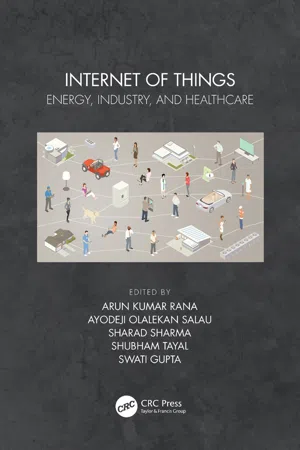
Internet of Things
Energy, Industry, and Healthcare
- 310 pages
- English
- ePUB (mobile friendly)
- Available on iOS & Android
Internet of Things
Energy, Industry, and Healthcare
About this book
Internet of things (IoT) is the connection and communication of physical objects (smart devices) over the internet. In this recent age, people's daily lives are dependent on the internet through their smartphones, tablets, Smart TVs, micro-controllers, Smart Tags, computers, laptops, and cars to name a few. This book discusses different ways to create a better IoT network and/or IoT platforms to improve the efficiency and quality of these products and subsequently their users' lives. In addition, this book provides future research directions in energy, industry, and healthcare, and explores the different applications of IoT and its associated technologies. It provides an overview and explanation of the software architecture, middleware, data processing and data management as well as security, sensors, actuators and algorithms used to create a working IoT platform. The editors then go on to examine IoT networks and platforms as they relate to energy industry including, energy efficiency and management, intelligent energy management, smart energy through blockchain and energy-efficient/aware routing/scheduling challenges and issues. They then explore IoT as it applies to healthcare including biomedical image and signal analysis and disease prediction and diagnosis. Finally the editors examine the prospects and applications of IoT for industry through the concepts of smart industry, including architecture, blockchain, and Industry 4.0. This book is intended for senior undergraduate and graduate students, researchers and industry professionals working on IoT applications and infrastructure.
-
- Reviews IoT software architecture and middleware, data processing and management, security, privacy and reliability, architectures, protocols, technologies, algorithms, and smart objects, sensors, and actuators
-
- Explores IoT as it applies to energy, including energy efficiency and management, intelligent energy management, smart energy through blockchain and energy-efficient/aware routing/scheduling challenges and issues Examines IoT as it applies to healthcare including biomedical image and signal analysis, and disease prediction and diagnosis
-
- Examines IoT as it applies to smart industry including architecture, blockchain, and Industry 4.0
-
- Discusses different ways to create a better IoT network or IoT platform
Frequently asked questions
- Essential is ideal for learners and professionals who enjoy exploring a wide range of subjects. Access the Essential Library with 800,000+ trusted titles and best-sellers across business, personal growth, and the humanities. Includes unlimited reading time and Standard Read Aloud voice.
- Complete: Perfect for advanced learners and researchers needing full, unrestricted access. Unlock 1.4M+ books across hundreds of subjects, including academic and specialized titles. The Complete Plan also includes advanced features like Premium Read Aloud and Research Assistant.
Please note we cannot support devices running on iOS 13 and Android 7 or earlier. Learn more about using the app.
Information
1 VANET-Based Intelligent Traffic Light Control System by Detecting Congestion Using Fuzzy C-Means Clustering Technique in a Smart City
1.1 Introduction
Table of contents
- Cover
- Half Title
- Title Page
- Copyright Page
- Contents
- Editor Biographies
- List of Contributors
- Chapter 1: VANET-Based Intelligent Traffic Light Control System by Detecting Congestion Using Fuzzy C-Means Clustering Technique in a Smart City
- Chapter 2: Internet of Things Advancements in Healthcare
- Chapter 3: IoT-Based Artificial Intelligence System in Object Detection
- Chapter 4: A Value Parity Combination-Based Scheme for Heartbeat Sounds Protection
- Chapter 5: Sentiment Analysis of Product Reviews Using IoT
- Chapter 6: Saccadic Scan Path Predicting Using Convolutional Auto Encoders
- Chapter 7: Impact of IIOT in Future Industries: Opportunities and Challenges
- Chapter 8: Privacy and Ethical Issues in Digitalization World
- Chapter 9: A Review on Smart Traffic Management System
- Chapter 10: A Robust Context and Role-Based Dynamic Access Control for Distributed Healthcare Information Systems
- Chapter 11: Impact of ICT on Handicrafts Marketing in Delhi NCR Region
- Chapter 12: Intelligent Amalgamation of Blockchain Technology with Industry 4.0 to Improve Security
- Chapter 13: Sensor Networks and Internet of Things in Agri-Food
- Chapter 14: Design and Development of Hybrid Algorithms to Improve Cyber Security and Provide Securing Data Using Image Steganography with Internet of Things
- Chapter 15: Optimal Automatic Power Generation Using Modified Hybrid Soft Computing Techniques
- Chapter 16: Steganography and Steganalysis Using Machine Learning
- Chapter 17: Gender Detection Based on Machine Learning Using Convolutional Neural Networks
- Chapter 18: Smart Technologies and Social Impact: An Indian Perspective of Contactless Technologies for Pandemic
- Chapter 19: Agriculture-Internet of Things (A-IoT) Key Roles in Addressing Some Challenges in Agriculture
- Index